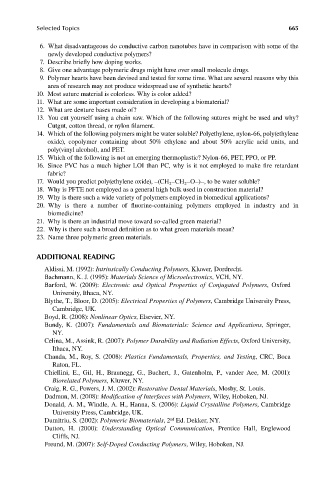Page 702 - Carrahers_Polymer_Chemistry,_Eighth_Edition
P. 702
Selected Topics 665
6. What disadvantageous do conductive carbon nanotubes have in comparison with some of the
newly developed conductive polymers?
7. Describe briefly how doping works.
8. Give one advantage polymeric drugs might have over small molecule drugs.
9. Polymer hearts have been devised and tested for some time. What are several reasons why this
area of research may not produce widespread use of synthetic hearts?
10. Most suture material is colorless. Why is color added?
11. What are some important consideration in developing a biomaterial?
12. What are denture bases made of?
13. You cut yourself using a chain saw. Which of the following sutures might be used and why?
Cutgut, cotton thread, or nylon fi lament.
14. Which of the following polymers might be water soluble? Polyethylene, nylon-66, poly(ethylene
oxide), copolymer containing about 50% ethylene and about 50% acrylic acid units, and
poly(vinyl alcohol), and PET.
15. Which of the following is not an emerging thermoplastic? Nylon-66, PET, PPO, or PP.
16. Since PVC has a much higher LOI than PC, why is it not employed to make fi re retardant
fabric?
17. Would you predict poly(ethylene oxide), –(CH –CH –O–)–, to be water soluble?
2 2
18. Why is PFTE not employed as a general high bulk used in construction material?
19. Why is there such a wide variety of polymers employed in biomedical applications?
20. Why is there a number of fluorine-containing polymers employed in industry and in
biomedicine?
21. Why is there an industrial move toward so-called green material?
22. Why is there such a broad definition as to what green materials mean?
23. Name three polymeric green materials.
ADDITIONAL READING
Aldissi, M. (1992): Intrinsically Conducting Polymers, Kluwer, Dordrecht.
Bachmann, K. J. (1995): Materials Science of Microelectronics, VCH, NY.
Barford, W. (2009): Electronic and Optical Properties of Conjugated Polymers, Oxford
University, Ithaca, NY.
Blythe, T., Bloor, D. (2005): Electrical Properties of Polymers, Cambridge University Press,
Cambridge, UK.
Boyd, R. (2008): Nonlinear Optics, Elsevier, NY.
Bundy, K. (2007): Fundamentals and Biomaterials: Science and Applications, Springer,
NY.
Celina, M., Assink, R. (2007): Polymer Durability and Radiation Effects, Oxford University,
Ithaca, NY.
Chanda, M., Roy, S. (2008): Plastics Fundamentals, Properties, and Testing, CRC, Boca
Raton, FL.
Chiellini, E., Gil, H., Braunegg, G., Buchert, J., Gatenholm, P., vander Aee, M. (2001):
Biorelated Polymers, Kluwer, NY.
Craig, R. G., Powers, J. M. (2002): Restorative Dental Materials, Mosby, St. Louis.
Dadmun, M. (2008): Modifi cation of Interfaces with Polymers, Wiley, Hoboken, NJ.
Donald, A. M., Windle, A. H., Hanna, S. (2006): Liquid Crystalline Polymers, Cambridge
University Press, Cambridge, UK.
nd
Dumitriu, S. (2002): Polymeric Biomaterials, 2 Ed. Dekker, NY.
Dutton, H. (2000): Understanding Optical Communication, Prentice Hall, Englewood
Cliffs, NJ.
Freund, M. (2007): Self-Doped Conducting Polymers, Wiley, Hoboken, NJ.
9/14/2010 3:44:10 PM
K10478.indb 665
K10478.indb 665 9/14/2010 3:44:10 PM

